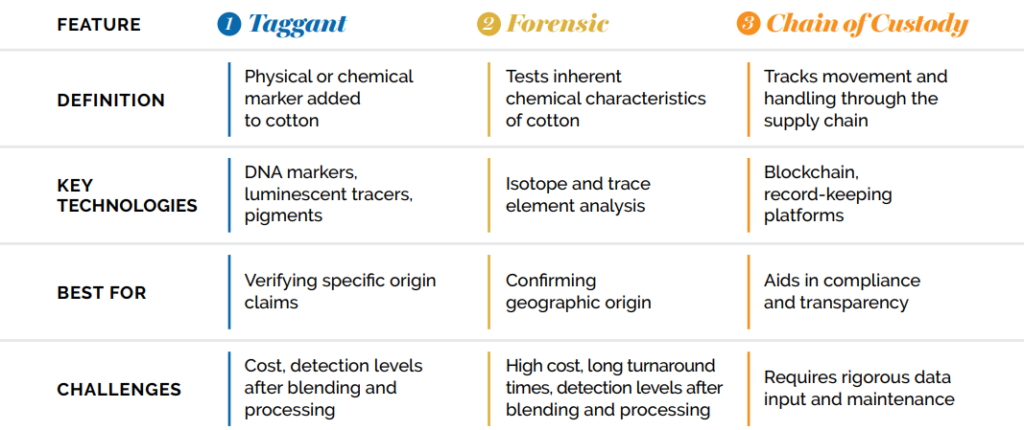Cotton Traceability Technologies
Considerations When Evaluating Traceability Technologies
Cotton Incorporated works with companies and technology providers to help companies make informed decisions about cotton traceability. Although not all information about traceability technologies is publicly available, Cotton Incorporated has identified characteristics and capabilities of these methods for companies to consider when thinking about traceability solutions.
Even when providers’ websites give detailed information about the technologies, descriptions of processes tend to be vague, and performance claims need to be confirmed or qualified. Before making decisions, companies will likely need to ask providers for further information or a demonstration. Testimonials or user reviews of specific offerings also can be helpful.
The Three Main Traceability Methods
Cotton traceability methods fall into three general categories: Taggant, Forensic, and Chain of Custody. These methods may be used separately or in combination, depending on a company’s traceability needs and goals.

For more information on cotton traceability technologies, download our Traceability Technologies Brochure.
General Considerations with Traceability Technologies
These are major considerations in evaluating taggant and forensic traceability technologies:
- The implications of blending — with cotton from different sources or with other types of
fibers — and the stages at which blending occurs, from ginning through sliver and roving formation
to knitting or weaving. - The effects of textile processing on the test’s reliability — whether the technology can withstand
the mechanical and chemical processes of textile manufacturing. - The level of sampling required to ensure test results with a high level of statistical confidence.
Companies need to consider the following questions in evaluating which cotton traceability solutions will
best meet their needs.
Single-Origin Cotton vs. Blends
- How effective is the technology at confirming that (1) products contain only cotton from a single origin or (2) products contain no cotton from a particular origin?
- How effective is the technology at tracing cotton from a specific source after it has been blended with (1) cotton from other sources or (2) other types of fiber (plant, animal, synthetic)?
- How much marked cotton must be present in a sample (percentage content) in order to be detectable?
- Does the technology measure the percentage of marked cotton in a sample, or simply its presence
or absence? - What are the accuracy, error, and precision of the testing method?
Processing or Supply-Chain Stage
- At what stages in the supply chain does cotton need to be tracked?
- At which stages of production is the technology effective — with raw fiber, processed fiber, yarn, greige fabric, finished fabric, or manufactured and laundered products?
- Do the accuracy, error, and precision of testing differ at different stages in production or points along the supply chain?
Availability and Cost
- How readily available is the technology for use with cotton? Does the provider’s location matter (domestic vs. overseas)?
- What is the cost? Cost information generally is not published, and providers base their estimates on the size, scope, and volume of the testing program and the specific services desired.
- What is the turnaround time for test results?
Assurances
- What level of statistical confidence does the test provide?
- If origin is “certified,” what assurances does the provider give about the certainty of the findings,
and on what basis? - How vulnerable is the technology to fraud?
Independent Software Providers
U.S. Customs and Border Protection recommends that importers of cotton products assemble appropriate documentation that can assist with establishing a supply chain of custody record for all tier suppliers. To assist your company, Cotton Incorporated has compiled this list of potential information management software suppliers with relevant products/services.
Taggant Methods
This list is not exhaustive and there may be additional suppliers with appropriate capabilities. Cotton Incorporated cannot guarantee that each company has the ability or willingness to deliver a particular product or service. Although we make every attempt to keep this list up to date, there may be cases where a company’s capabilities or status may have changed.
Cotton Incorporated is providing this list as a courtesy but makes no warranty or representation, either expressed or implied, with respect to the suppliers contained herein. Likewise, no statement contained herein shall be construed as a recommendation to use a specific supplier and Cotton Incorporated assumes no responsibility for any negligence on the part of any supplier included in this list.